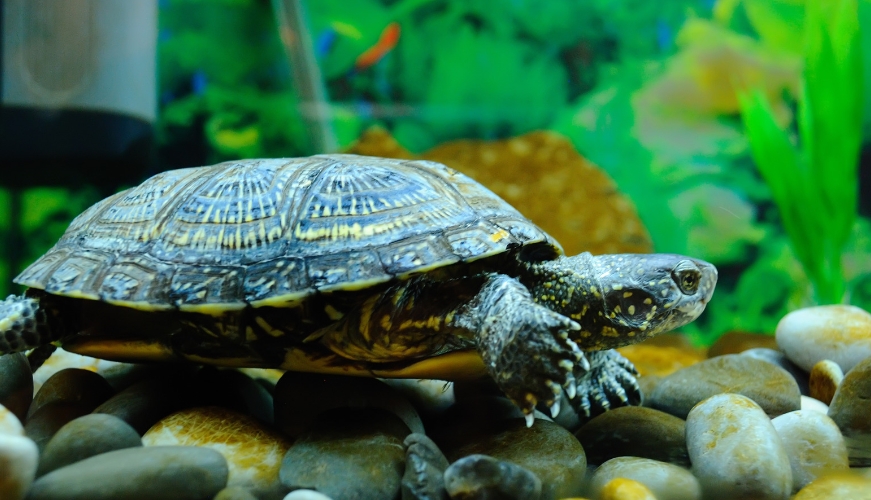Will Pet Turtles Survive in the Wild? Key Insights & Advice
Owning a pet turtle can be a rewarding experience, but some owners might wonder ‘Will pet turtles survive in the wild?’. Before acting on this instinct, it’s crucial to understand the consequences and to explore better alternatives. This article delves into why releasing pet turtles into the wild is not advisable, offers alternatives for responsible pet ownership, and provides actionable advice for turtle enthusiasts.

Why You Shouldn’t Release Pet Turtles into the Wild
Releasing pet turtles into the wild might seem like a humane choice, but it poses several risks. These challenges range from survival skills to ecological impacts.
They Might Not Find Enough Food
Pet turtles are used to a controlled diet. In the wild, they need to forage for food, which is not always readily available.
Diet Diversity:
Pet turtles often rely on a consistent selection of commercial turtle food, vegetables, and occasional proteins.
Wild food sources vary and may not meet their dietary needs.
Inconsistent access to nourishment can lead to malnutrition or starvation.
Foraging Skills:
Captive turtles typically lack the foraging skills needed to locate and capture food.
Instincts honed over thousands of years might be dulled in a turtle that’s had food placed directly in its enclosure.
Competing for food with wild animals can pose an additional challenge.
They Will Contract or Release Disease
Diseases present another major concern. Pet turtles can both contract and spread illnesses when introduced into the wild.
Health Risks:
Captive turtles might carry pathogens or parasites unfamiliar to wild turtles.
Ill-equipped to handle new illnesses, they might become severely ill.
Their immune systems might not be robust enough to fight wild diseases.
Environmental Impact:
Introducing new bacteria or viruses can devastate wild turtle populations.
Disease transmission can extend to other wildlife, causing wider ecological damage.
Even if the pet turtle appears healthy, it could be a carrier of harmful pathogens.
They Can’t Compete with Wild Turtles
Pet turtles often lack the survival mechanisms needed to thrive in nature. This inability to compete becomes a significant barrier.
Predatory Pressure:
Captive turtles are unaccustomed to predators.
Unable to recognize or respond to threats, they become easy prey.
Loss of turtle populations can imbalance local ecosystems.
Shelter and Space:
Finding safe habitats is second nature to wild turtles but challenging for those raised in tanks.
Lack of proper sheltering skills exposes pet turtles to environmental hazards.
Territorial disputes with wild turtles can lead to injuries or even death.
The Local Environment Might Not Be Suitable
Another critical issue is the compatibility of your pet turtle with the local environment, which can be highly variable.
Climactic Challenges:
Temperature, humidity, and water quality in the local habitat may be unsuitable.
Turtles used to regulated environments might struggle to adapt to broader weather patterns.
Climate fluctuation can lead to stress, affecting the turtle’s overall well-being.
Invasive Species:
Introducing a non-native turtle to a new habitat can disrupt local ecosystems.
They might predate on or outcompete indigenous species for resources.
This displacement can result in ecological imbalances.
What Alternatives Are Available for Pet Turtle Owners?
Instead of releasing your pet turtle into the wild, consider these responsible alternatives that ensure both the turtles and the environment remain safe.
Rehome Your Turtle:
Look for friends, family, or local community members interested in adopting.
Animal shelters and turtle rescue groups often facilitate responsible rehoming.
Ensure the new caretaker is well-informed about turtle care requirements.
Contact a Local Wildlife or Rescue Organization:
Many organizations specialize in taking in unwanted pets.
They possess the expertise to provide the right environment and care.
Some wildlife refuges have programs for captive turtle integration under controlled conditions.
Build a Turtle Enclosure in Your Backyard:
Create a safe, outdoor habitat that mimics natural conditions.
Ensure the enclosure is escape-proof and protected from predators.
This option allows your turtle to experience a more natural setting without risks.
Conclusion
Will pet turtles survive in the wild? The answer is negative. Releasing pet turtles into the wild presents numerous challenges, including food scarcity, disease spread, and ecological disruption. Instead, responsible pet owners should look for safe and humane alternatives, such as rehoming or creating a secure outdoor enclosure. These steps ensure that both your pet and the local ecosystem remain healthy and balanced. Making an informed decision can profoundly impact your turtle’s well-being and the environment.
FAQ
Can turtles survive in the wild after captivity?
Survival in the wild after captivity is difficult. Captive turtles lack essential survival skills and face various ecological challenges which make it unlikely for them to thrive.
Is it illegal to release pet turtles?
In many regions, it is illegal to release pet turtles into the wild. Laws are designed to protect native ecosystems from disruption and to prevent the spread of diseases.
Can you let a pet turtle go in a pond?
Releasing a pet turtle into a pond is not recommended. It can disrupt the local ecosystem, spread disease, and the turtle likely lacks the skills to survive.
